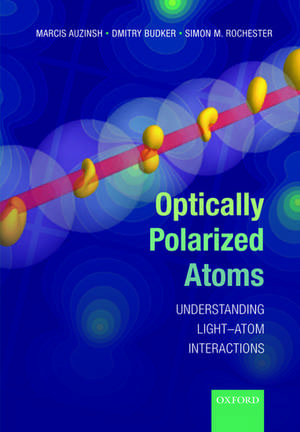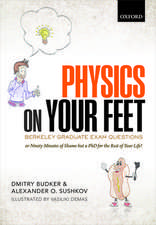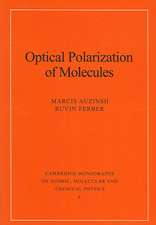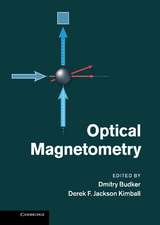Optically Polarized Atoms: Understanding light-atom interactions
Autor Marcis Auzinsh, Dmitry Budker, Simon Rochesteren Limba Engleză Paperback – 24 apr 2014
| Toate formatele și edițiile | Preț | Express |
|---|---|---|
| Paperback (1) | 236.96 lei 31-37 zile | |
| Oxford University Press – 24 apr 2014 | 236.96 lei 31-37 zile | |
| Hardback (1) | 541.00 lei 31-37 zile | |
| OUP OXFORD – 22 iul 2010 | 541.00 lei 31-37 zile |
Preț: 236.96 lei
Preț vechi: 333.56 lei
-29% Nou
Puncte Express: 355
Preț estimativ în valută:
45.34€ • 47.34$ • 37.53£
45.34€ • 47.34$ • 37.53£
Carte tipărită la comandă
Livrare economică 25-31 martie
Preluare comenzi: 021 569.72.76
Specificații
ISBN-13: 9780198705024
ISBN-10: 0198705026
Pagini: 390
Ilustrații: 145 b/w line illustrations
Dimensiuni: 174 x 247 x 18 mm
Greutate: 0.77 kg
Editura: Oxford University Press
Colecția OUP Oxford
Locul publicării:Oxford, United Kingdom
ISBN-10: 0198705026
Pagini: 390
Ilustrații: 145 b/w line illustrations
Dimensiuni: 174 x 247 x 18 mm
Greutate: 0.77 kg
Editura: Oxford University Press
Colecția OUP Oxford
Locul publicării:Oxford, United Kingdom
Recenzii
This is an excellent undergraduate textbook which provides a modern treatment of atom-light interactions from an experimentalist's perspective. I recommend this book to any student who aims for a deep understanding of the concepts in atomic physics and how to apply them to current research topics.
Many modern atomic physics experiments use subtle effects of atom-light interactions, be they the destructive interference associated with coherent superpositons, or the dynamics of optical pumping, or alignment to orientation conversion. Having such topics discussed in a coherent theoretical framework provides an excellent resource.
I highly recommend 'Optically Polarized Atoms' and will probably use it next time I teach my graduate course. [...] The book is specifically intended for use in a one-semester course in which the symmetry and angular-momentum aspects of atomic structure and laser-atom interactions are central. [...] The level of detail and the clarity of explanations are admirable.
The recently published book 'Optically Polarized Atoms' by Marcis Auzinsh, Dmitry Budker and Simon M. Rochester will be a unique and valuable addition to the library of anyone -- students or established researchers [...] It provides a rich mine of information about atomic physics that is hard to find elsewhere. I intend to keep a copy on my shelf of favorite physics books.
Many modern atomic physics experiments use subtle effects of atom-light interactions, be they the destructive interference associated with coherent superpositons, or the dynamics of optical pumping, or alignment to orientation conversion. Having such topics discussed in a coherent theoretical framework provides an excellent resource.
I highly recommend 'Optically Polarized Atoms' and will probably use it next time I teach my graduate course. [...] The book is specifically intended for use in a one-semester course in which the symmetry and angular-momentum aspects of atomic structure and laser-atom interactions are central. [...] The level of detail and the clarity of explanations are admirable.
The recently published book 'Optically Polarized Atoms' by Marcis Auzinsh, Dmitry Budker and Simon M. Rochester will be a unique and valuable addition to the library of anyone -- students or established researchers [...] It provides a rich mine of information about atomic physics that is hard to find elsewhere. I intend to keep a copy on my shelf of favorite physics books.
Notă biografică
Marcis Auzinsh is the Rector of the University of Latvia, where he was previously Chairman of the Senate, Dean of the Faculty of Physics and Mathematics, and Head of Center of Excellence for Basic Research in Nanoscale Physics and Application. He has held visiting positions at universities around the world, and is a Member of Executive Commitee of the European Physical Society.Dmitry Budker took his PhD at the University of California at Berkeley, where he won the 1994 American Physical Society Award for Outstanding Doctoral Thesis Research in Atomic, Molecular, or Optical Physics. He is now a Professor of Physics there. In 2005 he was elected a Fellow of the American Physical Society, and in 2009 became a American Physical Society Outstanding Referee.Simon M. Rochester is a Graduate Student Researcher at the University of California at Berkeley, where he holds a NASA Earth System Science Fellowship.





